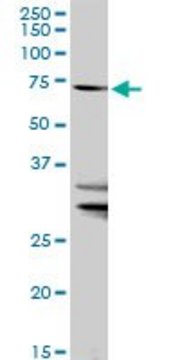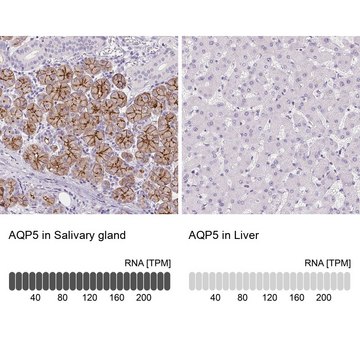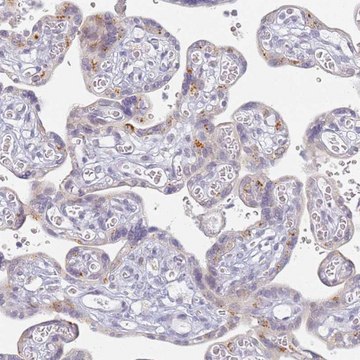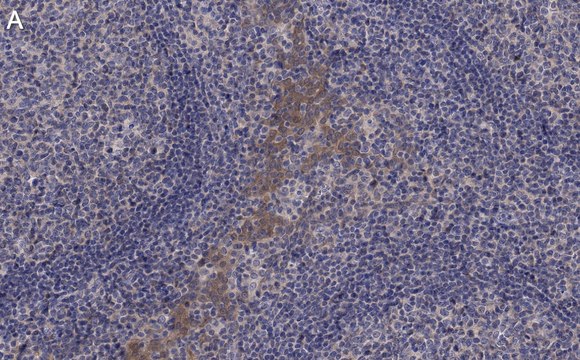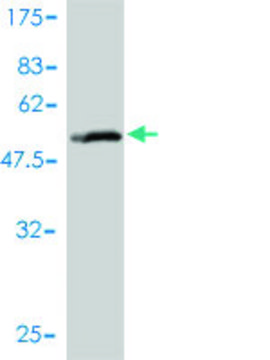Recommended Products
biological source
rabbit
Quality Level
conjugate
unconjugated
antibody form
purified antibody
antibody product type
primary antibodies
clone
polyclonal
mol wt
calculated mol wt 72.32 kDa
observed mol wt ~60 kDa
purified by
(Unpurified)
species reactivity
human, mouse
species reactivity (predicted by homology)
monkey, rat
packaging
antibody small pack of 100 μL
technique(s)
western blot: suitable
isotype
IgG
epitope sequence
C-terminal
Protein ID accession no.
UniProt accession no.
shipped in
dry ice
target post-translational modification
unmodified
Gene Information
mouse ... Slc27a4(26569)
General description
Long-chain fatty acid transport protein 4 (UniProt: Q91VE0; also known as FATP-4, Fatty acid transport protein 4, Arachidonate--CoA ligase, Long-chain-fatty-acid-CoA ligase, Solute carrier family 27 member 4, Very long-chain acyl-CoA synthetase 4, ACSVL4) is encoded by the Slc27a4 (also known as AcsvI4, Fatp4) gene (Gene ID: 26569) in murine species. FATP4 is a multi-pass transmembrane protein with an endoplasmic reticulum (ER) localization domain and two transmembrane domains (aa 20-42 and 139-156). It is involved in translocation of long-chain fatty acids (LFCA) across the plasma membrane and has acyl-CoA synthetase activity towards long-chain and very-long-chain fatty acids (VLCFAs). It is abundantly expressed in small intestine, brain kidney, liver, skin, and heart. It is considered as the principal fatty acid transporter in small intestinal enterocytes and is present on the apical side of mature enterocytes. Its expression is also observed in the retinal pigment epithelium and in the retina. It is identified as a negative regulator of the ER-associated retinal pigment epithelium (RPE) 65 isomerase necessary for recycling 11-cis-retinal, the light-sensitive chromophore of both rod and cone opsin visual pigments. FATP4 is reported to indirectly inhibits RPE65 via substrate competition and via production of VLCFA derivatives like lignoceroyl-CoA. Deficiency of FATP4 in RPE is shown to cause a significant increase in the level of 11-cis and 9-cis-retinals that improves dark adaptation and survival function of rods in murine model of Leber congenital amaurosis (LCA). (Ref.: Li, S., et al. (2020). Proc. Natl. Acad. Sci. USA. 117(50); 32114-32123; Newberry, EP., et al. (2003). J. Biol. Chem. 278(51); 51664- 51672; Stahl, A., et al. (1999). Mol. Cell. 4(3); 299-308).
Specificity
This rabbit polyclonal antibody detects Fatty acid transport protein 4 (SLC27A4). It targets an epitope within 16 amino acids from the C-terminal region.
Immunogen
Linear Peptide corresponding to 16 amino acids from the C-terminal region of mouse Fatty acid transport protein 4 (SLC27A4).
Application
Quality Control Testing
Evaluated by Western Blotting in Hela cell lysate.
Western Blotting Analysis: A 1:1,000 dilution of this antibody detected SLC27A4/FATP4 in Hela cell lysate.
Tested Applications
Western Blotting Analysis: A 1:1,000 dilution from a representative lot detected SLC27A4/FATP4 in Mouse liver tissue lysate.
Western Blotting Analysis: A representative lot detected SLC27A4/FATP4 in Western Blotting applications (Newberry, E.P., et. al. (2003). J Biol Chem. 278(51):51664-72; Li, S., et. al. (2020). Proc Natl Acad Sci USA. 117(50):32114-32123).
Note: Actual optimal working dilutions must be determined by end user as specimens, and experimental conditions may vary with the end user
Evaluated by Western Blotting in Hela cell lysate.
Western Blotting Analysis: A 1:1,000 dilution of this antibody detected SLC27A4/FATP4 in Hela cell lysate.
Tested Applications
Western Blotting Analysis: A 1:1,000 dilution from a representative lot detected SLC27A4/FATP4 in Mouse liver tissue lysate.
Western Blotting Analysis: A representative lot detected SLC27A4/FATP4 in Western Blotting applications (Newberry, E.P., et. al. (2003). J Biol Chem. 278(51):51664-72; Li, S., et. al. (2020). Proc Natl Acad Sci USA. 117(50):32114-32123).
Note: Actual optimal working dilutions must be determined by end user as specimens, and experimental conditions may vary with the end user
This rabbit polyclonal Anti-SLC27A4/FATP4, Cat. No. ABS2221 is tested for use in Western Blotting, for the detection of Fatty acid transport protein 4 (FATP4).
Physical form
Rabbit polyclonal antibody in serum with 0.05% sodium azide.
Storage and Stability
Store at -10°C to -25°C. Handling Recommendations: Upon receipt and prior to removing the cap, centrifuge the vial and gently mix the solution. Aliquot into microcentrifuge tubes and store at -20°C. Avoid repeated freeze/thaw cycles, which may damage IgG and affect product performance.
Other Notes
Concentration: Please refer to the Certificate of Analysis for the lot-specific concentration.
Disclaimer
Unless otherwise stated in our catalog or other company documentation accompanying the product(s), our products are intended for research use only and are not to be used for any other purpose, which includes but is not limited to, unauthorized commercial uses, in vitro diagnostic uses, ex vivo or in vivo therapeutic uses or any type of consumption or application to humans or animals.
WGK
WGK 1
Regulatory Information
新产品
Certificates of Analysis (COA)
Search for Certificates of Analysis (COA) by entering the products Lot/Batch Number. Lot and Batch Numbers can be found on a product’s label following the words ‘Lot’ or ‘Batch’.
Already Own This Product?
Find documentation for the products that you have recently purchased in the Document Library.
Our team of scientists has experience in all areas of research including Life Science, Material Science, Chemical Synthesis, Chromatography, Analytical and many others.
Contact Technical Service